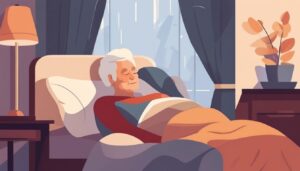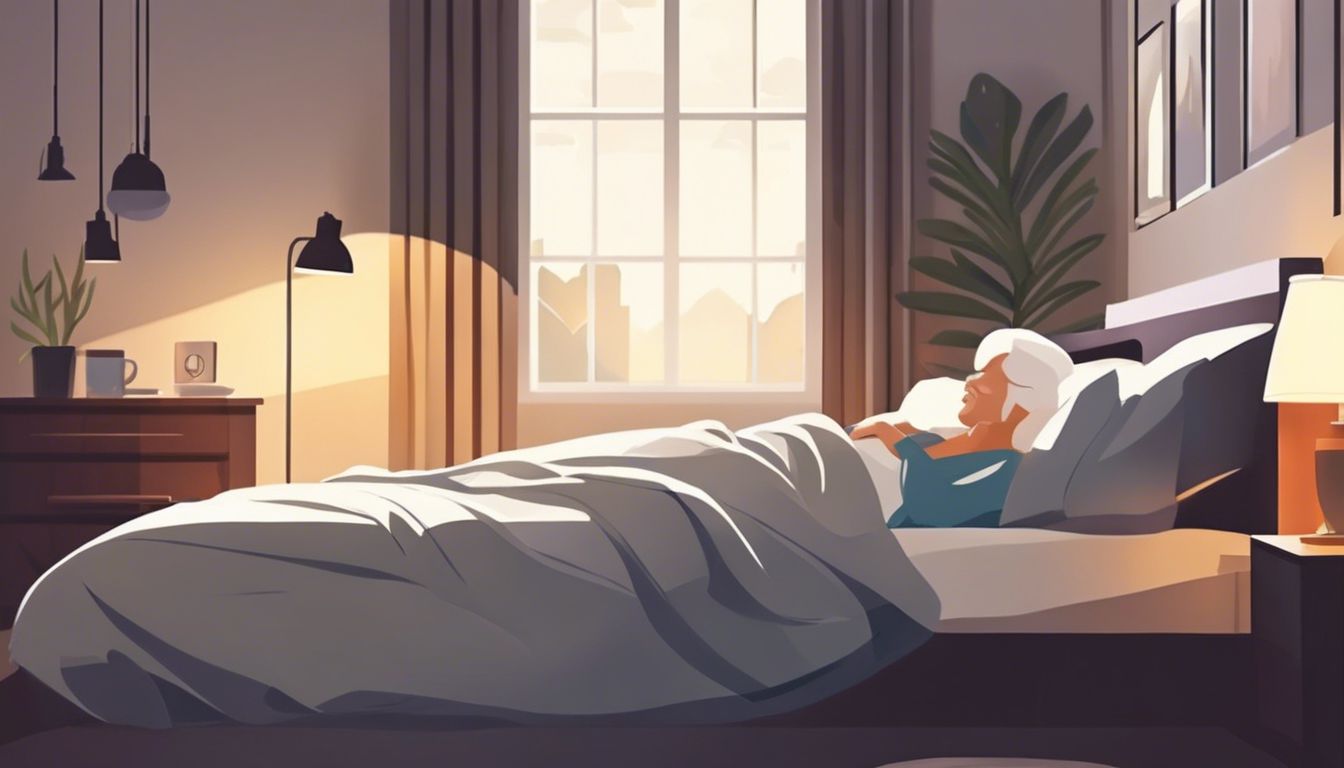Getting a good night’s sleep can be tough for seniors with back pain. Studies show that 8 out of 10 people experience back pain at some point in their lives. This article will explore the best sleep positions to ease discomfort and improve rest quality for older adults.
Read on to discover simple ways to find relief and wake up feeling refreshed.
📋✅
- Side sleeping with a pillow between the knees helps maintain proper spine alignment and reduces pressure on the lower back for seniors with back pain.
- Back sleeping with elevated legs relaxes lower back muscles and improves blood flow, while a pillow under the knees supports proper spinal alignment.
- A medium-firm mattress is recommended for seniors with back pain, and mattresses should be replaced every 6 to 8 years.
- Creating a comfortable bedroom environment with proper temperature (60-67°F), reduced noise, and controlled light exposure can significantly improve sleep quality for seniors with back pain.
- Using supportive pillows, such as full-length body pillows or wedge pillows, can provide additional comfort and alignment for seniors with back pain during sleep.
Understanding the Relationship Between Sleep and Back Pain in Seniors

Sleep and back pain in seniors often form a vicious cycle. Poor sleep can worsen back discomfort, while back pain disrupts sleep quality. This connection is especially significant for older adults, as 8 out of 10 people experience back pain at some point in their lives.
The lower back, which supports most of the body’s weight, is particularly vulnerable to age-related changes and injuries.
For many seniors, chronic back pain persists for three months or longer. This ongoing discomfort can lead to sleeping problems, creating a feedback loop of pain and poor rest. Research has shown a clear link between lower back issues and sleep disturbances.
In fact, an estimated 20% of acute low back pain cases become chronic, potentially impacting sleep patterns long-term. Addressing both sleep quality and back pain management is crucial for improving overall health and well-being in older adults.
Optimal Sleep Positions for Seniors with Back Pain
Finding the right sleep position can make a big difference for seniors with back pain. Certain positions can ease pressure on the spine and reduce discomfort, leading to better rest and less pain upon waking.
Side Sleeping Position
Side sleeping is often recommended for seniors with back pain. This position helps maintain proper spine alignment and reduces pressure on the lower back. For optimal comfort, seniors should slightly bend their knees and place a small pillow between them.
This technique supports the hips and prevents the upper leg from pulling the spine out of alignment.
A good night’s sleep is the best medicine for back pain.
Using a full-length body pillow can provide additional support for the entire body. It helps keep the spine neutral and alleviates stress on pressure points. Seniors with herniated discs or spinal stenosis may find relief by curling up slightly in a fetal position variant while side sleeping.
This opens up the spaces between vertebrae, potentially easing nerve compression and improving blood circulation.
Back Sleeping Position with Elevated Legs
Transitioning from side sleeping, another effective position for seniors with back pain is back sleeping with elevated legs. This approach offers several benefits for those struggling with discomfort.
Back sleeping with raised legs helps relax lower back muscles and improves blood flow. Caregivers can assist by placing a pillow under the senior’s knees and supporting their neck to maintain proper spinal alignment.
A firm sleeping surface enhances this position’s effectiveness. For added comfort, a small towel rolled under the knees can provide extra support. This setup allows the spine to rest in a neutral position, potentially easing pressure on sensitive areas and promoting better sleep quality.
Fetal Position Variant
The fetal position variant offers a comfortable sleep option for seniors with back pain. This position mimics the classic fetal pose but with a slight twist. Seniors lie on their side with knees bent towards the chest, not quite as tightly curled as a full fetal position.
A pillow placed between the knees provides extra support, aligning the spine and reducing pressure on the lower back.
This modified sleeping posture can ease discomfort for those with conditions like sciatica or herniated discs. It helps maintain proper spinal alignment and may decrease nerve compression.
For added comfort, seniors can use a body pillow to support their upper arm and torso, creating a more stable sleeping environment. This position also works well for those with sleep apnea, potentially reducing snoring and improving overall sleep quality.
Creating a Comfortable Bedroom Environment for Seniors
Creating a comfortable bedroom environment is crucial for seniors with back pain. A well-designed sleep space can significantly improve rest quality and reduce discomfort.
- Adjust room temperature: Keep the bedroom cool, ideally between 60-67°F (15-19°C), to promote better sleep.
- Reduce noise: Use soundproofing materials or white noise machines to minimize disruptive sounds.
- Control light exposure: Install blackout curtains or use sleep masks to block out unwanted light.
- Invest in a supportive mattress: Replace mattresses every 6-8 years or use a medium-firm mattress topper for enhanced comfort.
- Utilize an adjustable bed: This allows seniors to find optimal positions for pain relief and improved circulation.
- Arrange furniture for easy navigation: Ensure clear pathways to reduce fall risks during nighttime bathroom trips.
- Use appropriate bedding: Choose breathable, hypoallergenic materials to regulate body temperature and reduce allergens.
- Incorporate assistive devices: Install bed rails or grab bars to aid in getting in and out of bed safely.
- Maintain proper humidity: Use a humidifier to keep air moisture levels between 30-50% for respiratory comfort.
- Provide adequate lighting: Install motion-sensor night lights to illuminate paths without disrupting sleep.
Additional Tips for Enhancing Sleep Comfort
Sleep comfort goes beyond position. Your bedroom and bed setup play a big role in how well you rest. Let’s look at some easy changes that can make a world of difference for seniors with back pain.
Choosing the Right Mattress
Selecting the perfect mattress is crucial for seniors with back pain. Research backs the use of medium-firm beds to combat lower back discomfort. Mayo Clinic suggests replacing mattresses every 6 to 8 years.
For a budget-friendly option, adding a soft topper to an existing mattress can help. The bed’s condition and firmness play key roles in preventing or easing back issues.
Caregivers should consider mattress materials carefully. Memory foam often provides good support, molding to the body’s shape. Innerspring models offer firmness but may lack pressure point relief.
Hybrid options combine foam layers with coils, balancing comfort and support. Testing different types in-store can help find the best fit for a senior’s specific needs.
Using Pillows for Extra Support
Pillows offer more than just comfort for seniors with back pain. They can provide crucial support and alignment for better sleep quality and reduced discomfort.
- Full-length body pillows offer comprehensive support, cradling the entire body and promoting proper spinal alignment
- A pillow between the knees while side sleeping helps maintain hip alignment and relieves pressure on the lower back
- Placing a thin pillow under the lower back during back sleeping can fill the natural curve of the spine, reducing strain
- Elevating the legs with pillows relaxes lower back muscles and improves circulation, potentially easing pain and swelling
- A contoured cervical pillow supports the natural curve of the neck, preventing neck strain that can contribute to back issues
- Wedge pillows prop up the upper body, which may help with acid reflux and breathing issues that can disrupt sleep
- Memory foam pillows mold to the body’s shape, providing personalized support where it’s needed most
- Adjustable pillows allow seniors to customize the level of support for their unique needs and preferences
Proper sleep positions can make a world of difference for seniors battling back pain. By adopting the right posture and creating a supportive environment, older adults can find relief and improve their sleep quality.
Remember, what works best may vary from person to person. Experimenting with different positions and using supportive tools like pillows can lead to more restful nights and pain-free mornings.
Don’t hesitate to consult a healthcare provider for personalized advice on managing back pain through better sleep practices.
FAQs
1. What are the best sleeping positions for seniors with lower back pain?
Sleeping on your side with a pillow between your knees is great for seniors with lower back pain. It helps keep your spine aligned. Back sleeping with a pillow under your knees can also ease pressure on your lower back. Avoid stomach sleeping – it can strain your neck and back.
2. How can sleep posture affect back pain in older adults?
Poor sleep posture can worsen back pain and cause new aches. Good posture keeps your spine neutral, easing pressure on discs and nerves. It can help with conditions like degenerative disc disease, scoliosis, and lumbar spinal stenosis. A physical therapist can suggest the best sleep posture for your needs.
3. What type of mattress is best for seniors with chronic lower back pain?
A medium-firm foam mattress often works well for seniors with back pain. It supports your body while cushioning pressure points. Memory foam can be good for those with conditions like trochanteric bursitis. Always test a mattress before buying – comfort is key for good sleep.
4. Can obstructive sleep apnea worsen back pain in older adults?
Yes, sleep apnea can make back pain worse. It disrupts sleep, leading to poor posture and muscle tension. Using a continuous positive airway pressure (CPAP) machine can help. It improves sleep quality, which may ease back pain. Talk to your doctor if you suspect you have sleep apnea.
5. How can seniors improve their sleep hygiene to reduce back pain?
Good sleep hygiene can help manage back pain. Keep a regular sleep schedule. Use heat therapy before bed to relax muscles. Do gentle stretches recommended by your physical therapist. Create a comfy sleep environment with proper neck support. Avoid screens before bedtime – they can disrupt your sleep cycle.
6. When should seniors with back pain seek medical help for sleep issues?
See a doctor if back pain severely disrupts your sleep or if you have trouble sleeping for more than a few weeks. Get immediate help if you have back pain with fever, which could signal an infection. Persistent insomnia or hypersomnia can also warrant a check-up. A healthcare provider can rule out serious conditions and suggest treatments to improve your sleep and ease pain.









